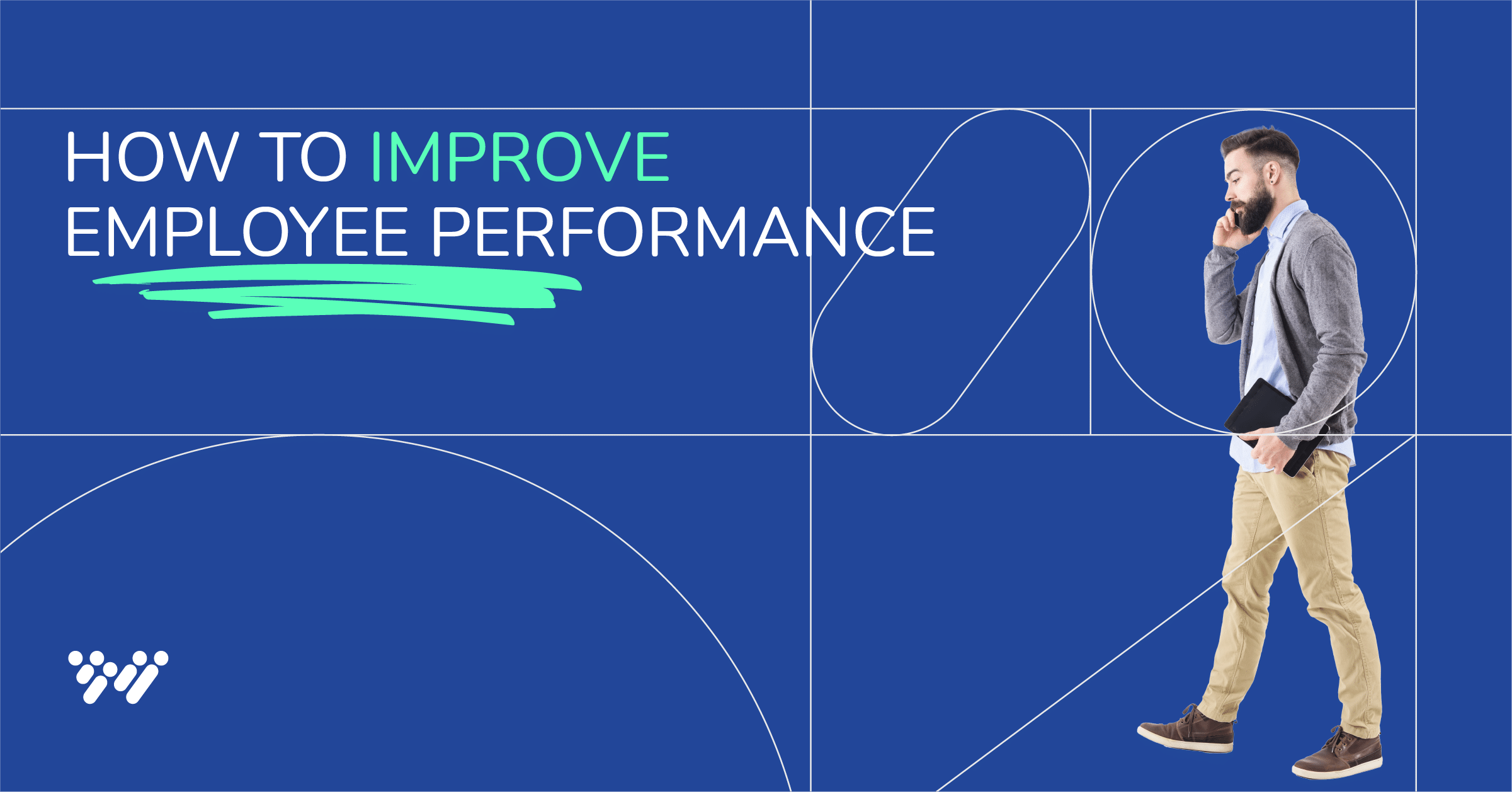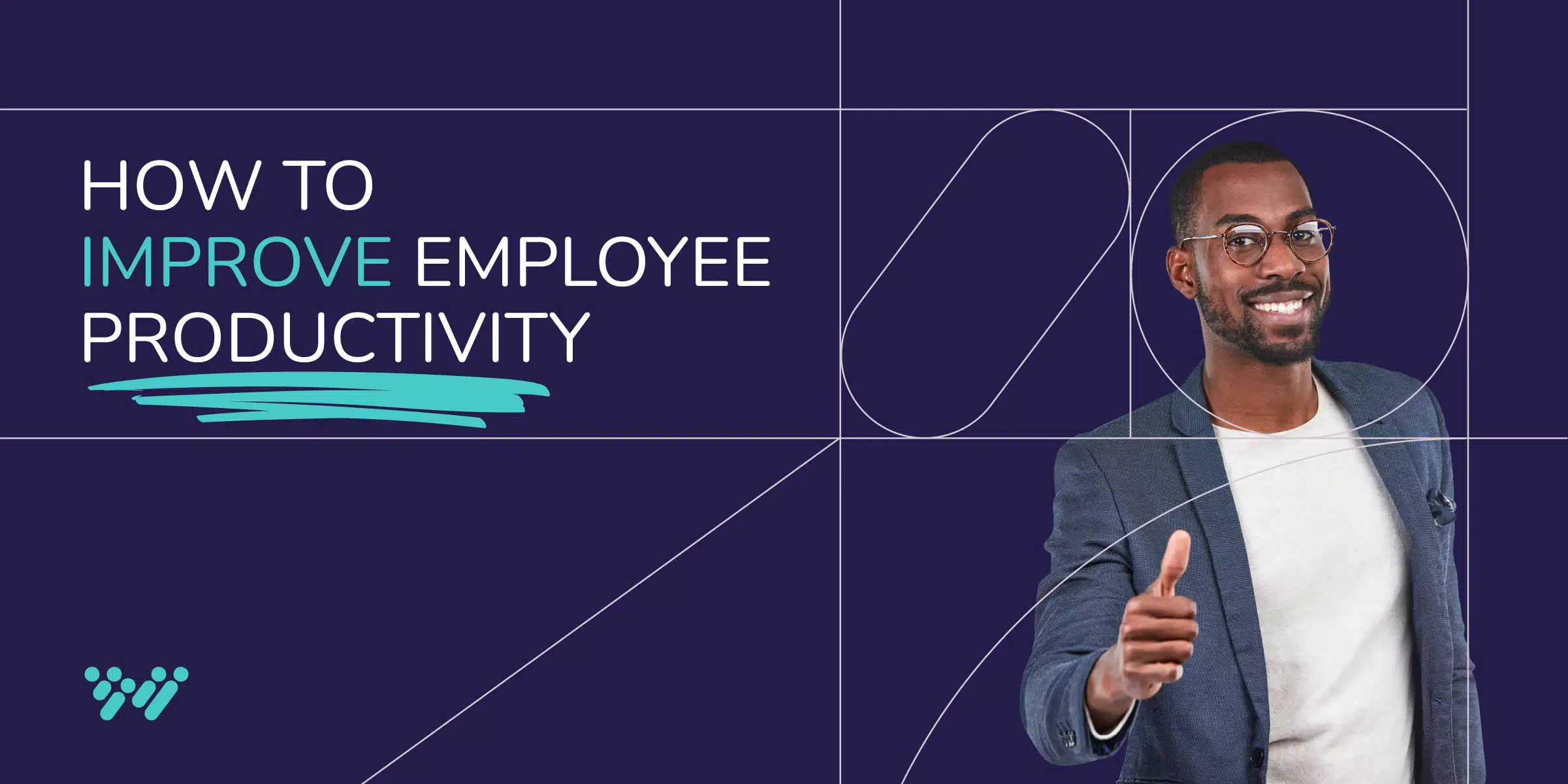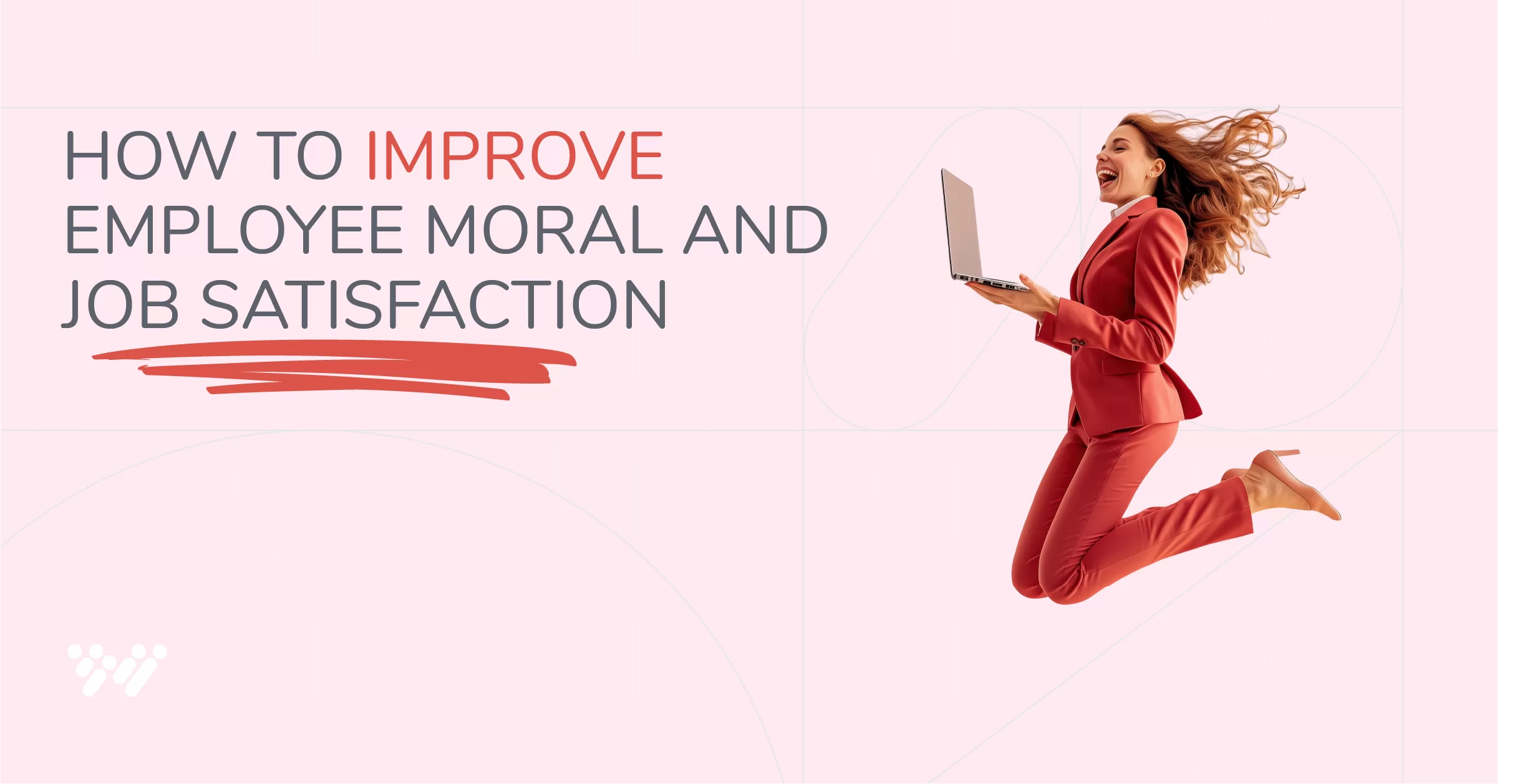“Work smarter, not harder; do more with less; prioritize ruthlessly.” We’ve all heard or even uttered these phrases, which have become an anthem for many workplaces. The goal behind these mantras is to improve productivity — and for good reason. Learning how to improve employee performance can significantly contribute to this goal.
Organizations that actively focus on their employees’ performance are 4.2 times more likely to outperform their peers, according to a recent study by McKinsey & Company, and they enjoy 30% higher revenue growth on average. That’s why many organizations have made improving employee performance a priority.
However, unless organizations understand the root causes of poor employee performance and how to improve it in measurable and long-lasting ways, organizations could end up making matters worse. Below, we’ll look at how to improve employee performance, including the reasons for low productivity and how to rectify them.
Table of contents
- What is employee performance?
- Why is improving employee performance critical to business success?
- Causes of poor employee performance
- How to improve employee performance in six steps
- Workplace benefits of improved employee performance
- How Wonderlic helps improve employee performance
- Get a demo of Wonderlic
- FAQ
What is employee performance?
Whereas employee productivity measures how much output an employee produces in a certain period of time, employee performance measures both the quantity and quality of an employee’s work. In essence, it indicates to what degree and how efficiently employees fulfill the responsibilities of their jobs.
The quantitative elements of performance are objective: A sales professional brings in a certain dollar amount of business each year, a warehouse manager reduces errors by a certain percentage, or a marketer generates a certain amount of pipeline or number of leads. However, the qualitative elements may be less obvious. For example, a salesperson who meets their quotas but continually denigrates the company and only helps teammates when pressured would have low overall employee performance. They might technically be a solid performer in terms of output, but their overall behavior can affect teammates and devastate team morale, causing a chain reaction of low employee performance.
Why is improving employee performance critical to business success?
Employees are an organization’s foundation. All it takes is one or two underperforming employees to nibble away at an organization’s structural integrity, leading to low performance, turnover, and other undesirable outcomes.
The impact of underperforming employees goes beyond their own missed quotas, deadlines, and other quantitative metrics. An employee’s colleagues who have to pick up the slack are bound to feel resentful or burnt out, and their own work might suffer, which in turn could lead to customer dissatisfaction and churn. Staff turnover could increase as well as high-performers search for opportunities at high-performing organizations.
44% of employees describe themselves as burnt out, according to SHRM, and 45% of them are looking for a new job, compared with just 16% of other employees. And while 56% of employees not suffering from burnout are willing to go above and beyond on the job, only 40% of burnt-out employees are.
Poor employee performance can be highly contagious. As people, we often mimic what we see, and if some workers are getting paid the same (or more) for less work, others might feel inclined to follow suit. Fortunately, high performance can also be infectious. For those reasons, organizations need to know how to galvanize employees and improve employee performance as soon as underperformance becomes apparent.
Causes of poor employee performance
Before you can determine how to help an employee improve performance, you have to get to the reasons why they’re underperforming — and there can be many of them. To reimagine a saying from author Leo Tolstoy, “Productive employees are all alike; each unproductive employee is unproductive for their own reason.” Nonetheless, several major common causes crop up time and again, regardless of the individual’s unique reasons.
Lack of resources — including training
You wouldn’t expect a mechanic to replace your brake pads without a jack or a car stand. Yet, too often, employees are expected to satisfactorily perform their jobs without the necessary resources. Sometimes, it’s physical, tangible resources that are lacking: up-to-date computer software, adequate safety gear, and warehouse storage space. However, a lack of intangible resources often proves to be just as counterproductive. And perhaps top of the list of those intangible resources is training.
A recent survey found that 90% of HR managers and 80% of employees believe training improves productivity. And not just training in hard skills. If an exceptionally skilled data analyst lacks communication skills, for instance, they’re less likely to understand exactly what the marketing team requires and to deliver results in a way the marketers can act upon.
Effective onboarding is another type of training resource missing from many organizations. A popular survey found that strong onboarding can improve productivity by more than 70%. Yet only 12% of employees believe their company did a good job onboarding them.
Personalize your onboarding experience with granular insights into how your employee prefers to learn and work. Get a demo of Wonderlic Select today.
Lack of growth opportunities
Employees don’t just want to be trained for the job they have; they want their employers to help prepare them for the job they want tomorrow. Without any opportunities for growth, employees may not see the point in putting their best foot forward. Satisfactory performance might not be enough.
In addition to myriad other benefits — attracting and retaining talent and closing skill gaps — employee development programs are a sign of good faith in team members. These programs prove that the organization is making an investment in them and wants to keep them for the long haul, which in turn encourages employees to invest the effort in peak performance.
Poor communication
“Poor communication kills” is more than a trope featured in Romeo and Juliet. While ineffective communication in the workplace might not be lethal, it can have serious consequences. In one workplace study, 44% of respondents said communication barriers led to project delays or failures, and 25% blamed them for missed performance goals.
Ambiguous messaging around goals and assignments isn’t the only communication failure that results in employee underperformance. A lack of feedback, recognition, and positive reinforcement also are contributing factors. Employees who aren’t shown what they’re doing wrong and how to fix it cannot be blamed for continuing to make the same errors. What’s more, receiving regular, meaningful feedback contributes to an employee’s desire to perform better, as does acknowledgment of a job well done. Nearly 80% of employees have admitted they would be more productive if they were recognized more frequently.
Low morale and engagement
All of the above contribute to low morale, as do a lack of trust, micromanagement, disrespect, and ever-changing and unrealistic goals. Any number of these results in what most would consider a toxic workplace, and since few people want to work in a toxic environment, the result is disengagement—or turnover—among employees.
Here are a few telling statistics:
- Lack of employee engagement costs the global economy an estimated $8.9 million a year, or 9% of GDP.
- Workplaces in the top quartile (25%) for employee engagement are 18% more productive in terms of sales and 14% more productive in other areas than organizations in the bottom quartile for engagement.
- Organizations with the most-engaged workforce are 23% more profitable than those with the least-engaged employees.
How to improve employee performance in six steps
Once you’ve identified the obstacles preventing employees from performing to the best of their abilities, you can remove those hurdles. Just as important, you can replace the stumbling blocks with catalysts for growth and productivity.
Step 1: Use onboarding to set up employees for success
An organization that expects employees to “hit the ground running” is setting them up for failure. Even Usain Bolt, the legendary Jamaican sprinter, didn’t hit the ground running; he had to learn to walk first. A thoughtful onboarding process spans not merely days or weeks but months. In addition to providing employees with mandatory compliance training, equipment, and information about policies and procedures, effective onboarding enables employees to get comfortable enough to do their best work and engaged enough to want to do it.
So, in addition to equipping new hires with manuals and a name badge, consider setting up one-to-one meetings for them with teammates, managers, and cross-functional partners; assigning them a mentor or buddy; or having them shadow a colleague. Schedule regular check-ins throughout the first few months and establish cascading goals and objectives.
Ideally, the onboarding process should, like other interactions, be tailored to the individual. For instance, some organizations make it a common practice to have newcomers eat lunch with colleagues during their first week; while that might foster camaraderie in some people, others might find it overwhelming. A hiring assessment tool such as Wonderlic Select not only helps you choose the best applicants for a job but also provides tips for customizing the onboarding process for each new hire.
Step 2: Set clear — and realistic — expectations
Employees shouldn’t have to guess what they’re supposed to achieve. Be sure to clearly define roles, responsibilities, and expectations. The SMART framework, in which goals are specific, measurable, assignable, realistic, and time-related, is a popular method of establishing clear expectations, though it’s certainly not the only one.
Keep in mind that even the most talented employee cannot work miracles. If you’ve never experienced a 25% year-over-year increase in sales, it’s probably unreasonable to expect your new hire to achieve it. If you expect your creative team to produce cutting-edge designs, be sure they have the up-to-date software to do so and that they know what a cutting-edge design looks like to you.
Step 3: Create and maintain a feedback loop
Regular, specific, and actionable feedback is key to improving employee performance. Scribbling “this is poorly written” on a report does nothing to help an employee improve — but it will make them stressed, angry, or demoralized, especially if they worked hard on the report.
On the other hand, explaining that you’d like the employee to minimize the jargon, eliminate redundancies, and add a few specific clarifying points will not only improve the outcome of this particular task but also equip the employee with the knowledge to help them write better reports going forward. Just as important, you’re taking the time and making the effort to provide this sort of guidance, which demonstrates your faith in their ability to improve, which in turn motivates them to do so. Keep in mind that constructive feedback differs from criticism — one gives advice or instruction to help them improve; the other tears them down without any helpful instruction.
In addition to offering constructive feedback on tasks, supervisors should regularly schedule check-ins with their employees. Annual performance reviews allow too much time for bad habits to set in. Quarterly, monthly, or weekly touch-base meetings help prevent small issues from escalating into large problems.
And be sure that feedback goes both ways. Employees should feel comfortable being honest about any issues they have with their supervisor, other team members, or the organization overall.
Step 4: Recognize effort as well as excellence
Not every employee can be the top salesperson, the fastest warehouse packer, or the programmer who writes the most code. While top performers deserve recognition, so do the employees who work hard and contribute significantly to an organization’s success. Hosting a thank-you lunch for staff who put in 12-hour days to fill holiday orders or acknowledging in a departmental meeting how a project manager’s consistent performance ensured tight deadlines were met goes a long way to boosting the productivity of the recognized employees as well as those who want to garner similar recognition.
Meet employees where they are
When it comes to being recognized, some people want to be awarded a plaque in front of a crowd, while others would rather receive a handwritten note. Some people learn best by doing; others need step-by-step instructions to excel. Some employees prefer to communicate via phone, others via email, and others still in person. The direct feedback appreciated by one employee might be considered brusque or rude by another, just as the weekly check-ins appreciated by one could be viewed as micromanaging by another.
In other words, one style doesn’t fit all when communicating with employees. Personality assessments can help you identify the most productive ways to engage with individuals and help them improve their performance. Interacting in a way that’s comfortable for you but not for them can result in miscommunication and create the impression that you don’t value them enough to compromise in this regard.
Step 5: Develop employees for the long term
Employee development benefits an organization by bolstering the skill set of its talent, of course. But just as important, by investing in the employees’ future in this way, the organization shows that it values its talent, which in turn encourages a more engaged, better-performing workforce. A scalable, self-directed employee development tool like Wonderlic Develop simplifies and streamlines the development process, ensuring that it is tailored to each individual. This enables smaller organizations to gain the same advantages as their larger counterparts.
Step 6: Foster a positive work environment
Implementing the above measures will go a long way to creating a more positive work environment and employees who are ready, willing, and able to perform to their fullest potential. While you’re at it, be sure your organization invests in other fundamentals of a productive workplace.
To prevent employee burnout, encourage a beneficial work-life balance with as much flexibility as is feasible. Consider implementing a strategic recruitment and productivity tool like a four-day workweek. Make the physical workspace safe, comfortable, clean, and well-lit so that people don’t dread spending time there. Offer health and wellness perks, if possible, such as gym memberships and stress-management resources. Beyond the advantages of these measures themselves, they also reinforce that the organization values its employees, motivating them to respond in kind by performing at their full potential.
Workplace benefits of improved employee performance
Employee performance improvement directly translates to improved organizational performance. A table with a wobbly leg might serve its purpose for a while, but eventually, the added stress on the other legs will cause them to break. Just as repairing that first rickety leg strengthens the entire table, improving even one employee’s performance betters the entire organization. Now, imagine the productivity boost when an organization implements tactics to improve the performance of multiple employees.
In addition to reducing turnover and employee stress, by improving employee performance, you’re also:
- Increasing revenue potential
- Reducing costs related to turnover and low productivity
- Building up high performers who are inclined to stay with your organization
- Improving customer relationships
- And more
How Wonderlic helps improve employee performance
Given the myriad factors involved in improving employee performance, organizations and their HR departments can use a helping hand. Wonderlic is a scalable, science-backed screening and development tool designed to simplify and streamline hiring and employee performance improvement in several ways:
Understand employee motivation and communication style
Wonderlic is a multi-measure pre-hire and post-hire assessment that measures employees’ cognitive ability, personality, and motivation relative to their role, giving recruiters an overall score for each candidate. Recruiters can compare candidates’ scores and drill down into specifics to see why candidates received a certain score, giving data-driven insights that help choose the best candidates with confidence. Motivation and personality assessments can also help you tailor your communication and onboarding strategies, helping you communicate and motivate effectively from the start.
Implement effective employee development
One reason employee development programs fall short—if they’re implemented at all—is the complexity of tailoring them to multiple roles and personalities. Wonderlic Develop offers role-based programs customized to each individual. Employees receive a breakdown of the role-critical attributes for success, along with accurate assessments of their strengths and weaknesses (highest-effort and least-effort attributes).
Just as important, Wonderlic Develop provides day-one actionable recommendations so that employees can improve their performance and time-tracked milestones to help them reach their career goals. Since Develop is self-led, the HR and management teams won’t be overwhelmed with additional managerial tasks. What’s more, employees feel empowered rather than micromanaged, adding to the sense of engagement and fulfillment.
Get a demo of Wonderlic
Want to better motivate your talent? Ready to help your employees improve their performance and productivity? Get started with a demo of Wonderlic today.
FAQ
Improving employee performance begins with understanding why employees are falling short of expectations. A lack of resources and employee development, poor communication, a failure to recognize excellence and effort, and an uninviting work environment are among the most common causes of employee underperformance. If the reasons are endemic to the organization, tackle them systemically. If they are affecting just one or two individuals, tailor your response to them.
While there is no one approach for achieving across-the-board employee performance improvement, these six steps address the most common causes of underperformance:
1) Implement a structured, multi-month onboarding process.
2) Set clear and realistic goals.
3) Provide and encourage regular constructive feedback.
4) Recognize effort as well as excellence.
5) Provide opportunities for employee development and growth.
6) Encourage a beneficial work-life balance and foster a positive workplace environment.
A self-directed, role-based employee development program is one of the most effective ways an employee can improve performance. A development tool like Wonderlic Develop provides each individual employee with personalized insights and tactics relative to their role so that they can improve their performance effectively.
Creating an engaging, positive work environment and providing employees with the training and other tools they need is essential to achieving optimal efficiency — as is clearly communicating expectations, goals, and guidelines.









